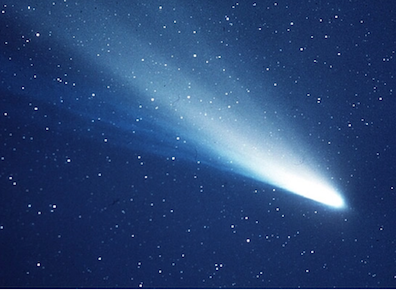Comets have "almost infinite compressibility" in the
sense that their spectacular tails are composed of tiny
particles of dust and water vapor that the sun's intense
radiation has boiled off a traveling ball of ice and rock.
Also long are their "vast elliptical egressive and
reentrant orbits," which in reentry take them to
a point near the sun ("perihelion") and in egress to a
point far away from it ("aphelion"). Only in close
proximity to the sun do comets put on the wonderfully "hirsute"
shows that awe human beings––Finnegans Wake calls them
"creamtocustard cometshair" (475.15) and imagines "combing
the comet's tail up right and shooting popguns at the
stars" (65.10-11). When they return to the deep, dark, cold
haunts of the outer planets, these iceballs "chancedrifting
through our system" (FW 100.33-34) fade away
into obscurity.
Comets are first introduced, inconspicuously, in Lestrygonians.
As Bloom stands on the O'Connell bridge worrying that Boylan
could give Molly a sexually communicable disease, he notes
that the "Timeball on the ballastoffice
is down. Dunsink time." This large ball on a pole in
downtown Dublin dropped once every 24 hours, letting people on
the quays know the exact time as communicated by wire from the
Dunsink observatory. The details are serendipitously similar
to those of a cosmic iceball that drops down into view at
certain predictable times. Almost immediately after this,
Bloom sees "A procession of whitesmocked men" moving
slowly toward him––another vision of the comet, with its
streaming white tail. As ever, Joyce's ingenuity here is
astonishing: Hely's men predict the
arrival of Halley's comet in 1910, as regular as a "Timeball"
after its usual 75-76 year absence. Finnegans Wake
documents Joyce's awareness of the fact: "like sixes and
seventies as eversure as Halley's comet" (54.8).
The 9th section of Wandering Rocks shows that the
linkage implied in Lestrygonians––Boylan visiting
Molly, a comet visiting the earth––is not accidental. Lenehan
and M'Coy see Bloom perusing books at a stall, prompting
Lenehan to recall that "I was with him one day and he bought a
book from an old one in Liffey street for two bob. There were
fine plates in it worth double the money, the stars and the
moon and comets with long tails. Astronomy it was
about." Then, laughing, "I'll tell you a damn good one
about comets' tails, he said. Come over in
the sun." The story concerns a night when the Blooms
shared a jaunting car with two
others coming back from Glencree over the dark deserted summit
of Featherbed Mountain, at "blue o'clock the morning" on "a
gorgeous winter's night." On one side of the car Bloom was
"pointing out all the stars and the comets in the heavens to
Chris Callinan and the jarvey: the great bear and Hercules and
the dragon, and the whole jingbang lot." On the other side
Lenehan was lecherously "lost, so to speak, in the milky way"
of Molly's breasts as the car's bumpy motion repeatedly threw
them together.
The linkage between comets and sexual hankypanky in this
scene involves yet another suggestive image. Molly that night
was wearing a "boa" which Lenehan kept strategically
adjusting around the curves of her body: "I was tucking the
rug under her and settling her boa all the time. Know what I
mean?" A boa is a long, light, feathery thing, quite
comparable to a comet's tail, and it is wrapped around a warm
body, like a comet snaking its way around the sun––as Joyce
emphasizes by having Lenehan tell M'Coy to come over in the
sun to hear about comets' tails. Readers may recall that
Molly's attractive warmth is a regular feature of Bloom's
erotic reveries.
Another such evocative image has appeared in the 5th section
of Wandering Rocks when Boylan "drew a gold watch
from his fob and held it at its chain's length." As in
the Lestrygonians passage, the suggestions of this
image are shaped by what comes immediately before and after.
In the preceding sentence, the sandwichboardmen are again seen
plodding along Grafton Street, this time through the windows
of Thornton's shop. Three short sentences later, there is a
reminder of Lenehan and the comets when Bloom is seen (via interpolation)
looking at books on the cart in Merchant's Arch. The watch and
chain––round head, long tail––clearly are intended to evoke
comets, the phallus, Blazes Boylan, and an unhappy husband.
But shape is not the only imagistic feature working quietly
away within the text. Comets are hirsute, and so is Boylan. In
Lestrygonians Nosey Flynn says, "O, by God, Blazes
is a hairy chap." In Hades Jack Power spots him
from the carriage "airing his quiff"––i.e., doffing his
hat to expose his hair to the air. In Circe Bello says
of Boylan, "He's no eunuch. A shock of red hair he has
sticking out of him behind like a furzebush! Wait for
nine months, my lad! Holy ginger, it's kicking and coughing up
and down in her guts already!" This sentence pins a tail on
Boylan, animalistically phallic but also comet-like, and it
associates the shape with sexual potency.
Hairiness is innately bound up with sexuality, as Circe
makes clear when the Nymph says that she and the stonecold
pure goddesses that Bloom scrutinizd in the National Museum
have "no
hair there." Bloom's rejection of this asexual ideal
associated with John Ruskin means that "a hairy chap" like
Boylan is inhairently threatening. This fear surfaces soon
afterward in Circe when Lenehan "officiously
detaches a long hair from Blazes Boylan's coat shoulder."
Not content to remark on head hairs, Lenehan proceeds to evoke
ones farther down: "Ho! What do I here behold? Were you
brushing the cobwebs off a few quims?" (Boylan, that is
to say, has been putting dusty vaginas back in working order.)
Boylan also is associated with the heavens. Wandering
Rocks notes his "skyblue tie" and his "socks with
skyblue clocks," and when the carriage arrives at 7 Eccles
Street in Sirens "Dandy tan shoe of dandy Boylan socks
skyblue clocks came light to earth." As a comet
approaches perihelion near earth, it lights up and becomes
light, hairy, diaphanous. "Clocks" were designs
embroidered on Victorian and Edwardian socks, but the
clocklike regularity of comets in the sky surely is intended
here.
The name "Boylan" suggests the sun's heat boiling away
water vapor from a comet, and "Blazes" is no less
evocative. Comets look like blazing fireworks, and the word
can also mean "a broad white stripe running the length of a
horse's face," or a similar rectangular "mark made on a tree
by cutting the bark so as to mark a route." In Oxen of the
Sun, a nebula-like apparition appears to draw on both
sorts of meaning: "It floats, it flows about her starborn
flesh and loose it streams, emerald, sapphire, mauve and
heliotrope, sustained on currents of cold interstellar wind,
winding, coiling, simply swirling, writhing in the skies a
mysterious writing till, after a myriad metamorphoses of
symbol, it blazes." This signifying apparition "looms,
vast, over the house of Virgo"––Molly's birth sign.
Many people once detected evil omens in comets, as in
Calpurnia's warning to Caesar: “When beggars die there are no
comets seen; / The heavens themselves blaze forth the
death of princes” (Julius Caesar 2.2.30-31). Such
fears were still alive when Halley's comet reappeared in 1910,
prompting Sir
Robert Ball, in an interview published on the front page
of the 17 May 1910 Bismarck Daily Tribune, to "set at
rest the fears of a grand catastrophe in the minds of those
folks who have been led to believe the comet contains
mischief-making potentialities." Responding to numerous
letter-writers, Ball noted that "a rhinoceros in full charge
would not fear collision with a cobweb, and the Earth need not
fear collision with a comet. In 1861 we passed through the
tail of a comet. No one knew anything about it at the time."
There is no reason to suppose that Joyce shared the popular
superstition about comets being portents, but he certainly
deployed it symbolically in his novel, using comet images to
suggest that Bloom's sexual reign at Eccles Street may be
coming to an end. The adulterer's blazing, boiling approach to
the sun implies Bloom's displacement, as is emphasized in Ithaca
when he imagines leaving home and wandering the earth in
emotional and perhaps financial destitution. In one paragraph
these thoughts of banishment are mapped onto the orbit of a
comet as it leaves behind the heat and light of the sun and
ventures to the cold edges of the known universe. But the
logic of the metaphor implies that one day, "suncompelled,"
Bloom will return from his "selfcompelled" exile:
Ever he would wander, selfcompelled, to the
extreme limit of his cometary orbit, beyond the fixed stars
and variable suns and telescopic planets, astronomical waifs
and strays, to the extreme boundary of space, passing
from land to land, among peoples, amid events. Somewhere
imperceptibly he would hear and somehow reluctantly,
suncompelled, obey the summons of recall. Whence, disappearing
from the constellation of the Northern Crown he would somehow
reappear reborn above delta in the constellation of Cassiopeia
and after incalculable eons of peregrination return an
estranged avenger, a wreaker of justice on malefactors, a dark
crusader, a sleeper awakened, with financial resources (by
supposition) surpassing those of Rothschild or the silver
king.
Having entertained the thought of such a triumphant return
Bloom quickly dismisses it, reflecting that while space may be
"reversible" time is not. (Nor is he likely to discover those
great riches, or to find himself transformed into a violent
avenger.) Nevertheless, this description of a "cometary orbit"
does insinuate thoughts of reversal and cyclicality. Thoughts
of falling to rise again preoccupied Joyce in the Wake, and
there is no doubt that at the end of Ulysses he was
already pondering them. After Bloom drops off into blackness
at the end of Ithaca, Molly's huge looping orbits of
thought distance her for a time from her husband but finally
bring her back to him––on Howth, in the sunshine, savoring
sexual pleasure.







